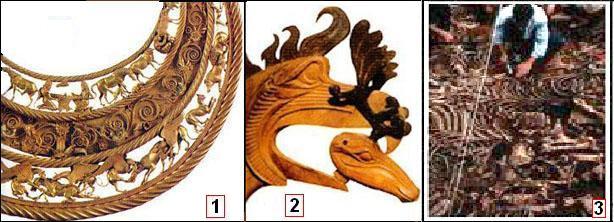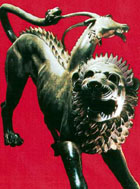|
Horses
played an important role in the life of the nomadic ancient
tribes. Groups of people could travel easily to long distances
and carry their goods with the help of their horses. The horse
was one of the earliest domesticated animals by humans. There
are several observations made to support the claim that the
modern horse “Equus caballus”
originated from Central Asia and spread to the world. Entire
horse remains have been found next to the burial chamber of
Asiatic rulers. There is first-hand information that ancient
shamans were leading the ceremony called
The Sacrifice
of the Horse. The person holding the head of the horse
to be sacrificed was called
Baž tutkan kiži meaning “The person holding the
head” in Turkic.
It was
mentioned in Chapter 21, The
Orhun Script that the word for horse in Turkish is
“At” and has a semantic relationship to “Ata” meaning
ancestor. The word “At” can also be used as a verb meaning “to
throw”. The reason for such a second use is not coincidental
and can be understood when the forgotten ancient beliefs are
stirred back to the surface.
The
ancient Central Asiatic people believed that the soul of a
person continued to exist after death and had to traverse a
dangerous underworld region populated by demons and griffins
before reaching its final destination in the sky. These
mythical animals (griffins and chimera) had lion claws, eagle
wings and beaks and were ready to tear apart any soul that
journeyed through the underworld. In order to secure a safe
journey for their dead leader through the underworld the
Asiatic nomadic tribes sacrificed horses as a lure for the
gryphon. While the gryphon attacked and devoured the soul of
the horse, the soul of the dead leader could escape and fly
towards the sky. The number of horses sacrificed depended on
the importance of the dead person. The more powerful the
person was the more horses followed him in the grave. This is
why the horse and the rider could not be separated even after
death (see Chapter 21).
The
horse is thrown to
the gryphon as an offering and this is why “At” is both a noun
and a verb. Recent archeological research has brought new
insight in this direction. In a kurgan at Kostromskaya
(north-western Russia), 22 horses were found next to the
chieftain (1).
At another kurgan in the Caucasus, remains of 360 horses were
found.

1.
Gold pectoral found at a kurgan (in Ukraine) illustrates in
extraordinary detail the Asiatic lifestyle and afterlife
beliefs of the nomads. The top row of the pectoral depicts
scenes from the daily life, while the bottom row illustrates
the underworld where wild animals reside. Several griffins are
seen attacking the “soul” of sacrificed horses.
2.
On a superb carved wooden standard, a griffin slays a stag.
Stags as well as horses were accepted to be distinguished
enough to follow the dead leader in his journey through the
underworld.
3.
Remains of horses, found in a kurgan, are being examined by an
archeologist.
One has
difficulty in understanding why so many horses were sacrificed
after a dead person. But the following words of Luc Kwanten
help us understand this ancient tradition
(2):
The
strength of the nomad lay not in numbers but in his
unsurpassed skills as a horseman and a warrior. Horses, the
steppe’s staple product, were available to the nomad in nearly
unlimited numbers, whereas for the sedentary states they were
frequently in short supply. The nomad thus possessed the
advantage of mobility.
It was
due to this mobility that nomadic tribes of Asia could cross
large distances and form new settlements. This is why we find
the symbolism of the “flying horse” in many cultures. In the
Greek Mythology Pegasus is the winged white horse that flew to
Mt. Olympus, where he took place in the stable of Zeus /
Jupiter. One of his wing feathers fell to earth close to
Tarsus giving the city its name. It is said that Pegasus bears
for Jupiter the lightning and thunder.

This
myth contains several clues related to our present subject.
The winged horse flies high up
toward the mythical Mt. Olympus were the main deity (Zeus /
Jupiter) resides. The meaning of Pegasus is not known but when
we spilt it into its constituent syllables we find
Pek-As-us “we are the
strong As”, where “pek” means “strong / solid”. The city of
Tarsus, located on the Mediterranean coast of Anatolia could
also be unfolded as Tur-As-us
meaning “we are Tur and As”. Not far from Tarsus are the
Taurus Mountains. Both Tarsus and Taurus contain the root-word
“Tur” discussed already in Chapter 14. Below we see some
examples of flying horses found in different parts of the
world.
1.
A drawing of Pegasus, the flying horse of Geek Mythology.
2.
A couple of terracotta winged horses perched on the roof of an
Etruscan tomb-house.
3.
The statue of a winged horse found at the entrance of a burial
mound in China.
4.
An ancient Chinese dish with the figure of the flying horse.
Below we see an Etruscan Chimera.

We can
conclude that the tradition of mixing animals and creating
mythical creatures such as griffins or chimera is of Asiatic
origin. Therefore, cultures where such symbolism is found are
clearly of Asiatic origin.
|